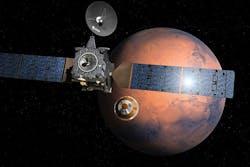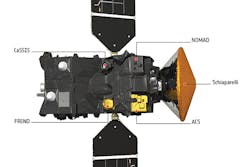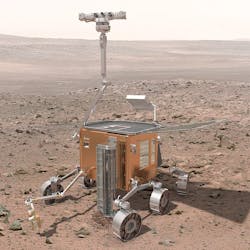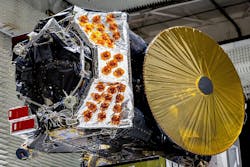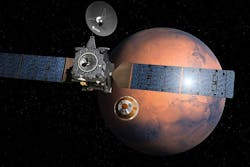Aerospace engineers choose radiation-tolerant Cobham microelectronic MRAMs for spectrometer instrument suite in ExoMars 2016 payload
COLORADO SPRINGS, Colo., 2 June 2016. Engineers at the Instituto de Astrofisica de Andalucia (IAA) and the Belgian Institute for Space Aeronomy (BIRA-IASB) needed radiation-tolerant microelectronics for the Nadir and Occultation for Mars Discovery (NOMAD) instrument on the ExoMars Trace Gas Orbiter (TGO). They found their solution at Cobham’s Semiconductor Solutions business unit, part of the Cobham Advanced Electronic Solutions sector, in Colorado Springs, Colorado.
The aerospace engineers incorporated Cobham’s Magnetoresistive Random-Access Memories (MRAMs) into the NOMAD spectrometer suite aboard the TGO, which launched to Mars on 14 March 2016. The MRAMs will assist the NOMAD instrument in measuring the spectrum of sunlight across a wide range of wavelengths, enabling the detection of components of the Martian atmosphere.
Cobham MRAMs were chosen due to the parts’ access time, data retention, and footprint, as well as radiation performance. Five MRAMs have been integrated on an interface board on the instrument. IAA confirmed in April that the board was powered on during flight and the MRAMs are working properly.
The ExoMars program is a joint endeavor between the European Space Agency (ESA) and the Russian Federal Space Agency (Roscosmos). The first mission of the ExoMars program is ExoMars 2016. It is scheduled to arrive at Mars in October 2016 and consists of a Trace Gas Orbiter (TGO) and an entry, descent, and landing demonstrator module (EDM) known as Schiaparelli. The main objectives of this mission are to search for evidence of methane and other trace atmospheric gases that could be signatures of active biological or geological processes and to test key technologies in preparation for ESA's contribution to subsequent missions to Mars.
“Cobham extends our sincere thanks to IAA, BIRA-IASB, and ESA, along with our congratulations on a successful design, launch, and mission,” says Jeff Hassannia, senior vice-president of business development and technology for Cobham Advanced Electronic Solutions.
Cobham Semiconductor Solutions is a global supplier of Standard HiRel ICs including memory, μprocessor, interconnect, power, and ASICs for space, commercial, medical, and industrial markets, along with Electronic Manufacturing Services (Circuit Card Assembly, Radiation Testing, Component Up-screening and Packaging). Cobham Semiconductor Solutions’ Colorado Springs site is a supplier of semicustom and standard VLSI circuits and custom circuit card assemblies. They have a Qualified Manufacturer List (QML) certification for Class Q, Class T and Class V.
Cobham is a global technology and services company providing solutions to the most challenging problems, from deep space to the depths of the ocean. The company employs more than 11,500 people on five continents, and has customers and partners in over 100 countries, with leading positions in: wireless, audio, video and data communications, including satellite communications; defense electronics; air-to-air refueling; aviation services; life support; and mission equipment.
You might also like:
Subscribe today to receive all the latest aerospace technology and engineering news, delivered directly to your e-mail inbox twice a week (Tuesdays and Thursdays). Sign upfor your free subscription to the Intelligent Inbox e-newsletter at http://www.intelligent-aerospace.com/subscribe.html.
Connect with Intelligent Aerospace on social media: Twitter (@IntelligentAero), LinkedIn,Google+, and Instagram.
Intelligent Aerospace
Global Aerospace Technology NetworkIntelligent Aerospace, the global aerospace technology network, reports on the latest tools, technologies, and trends of vital importance to aerospace professionals involved in air traffic control, airport operations, satellites and space, and commercial and military avionics on fixed-wing, rotor-wing, and unmanned aircraft throughout the world.
